Simulating the Shallow Groundwater Level Response to Artificial Recharge and Storage in the Plain Area of the Daqing River Basin, China
Abstract
:1. Introduction
2. Hydrogeological Settings
3. Changes in the GW Level
4. GW Flow Model
4.1. Conceptual Model
4.2. Numerical Model
4.3. Model Calibration
5. Artificial Recharge Scenarios and the Response of the GW Level
6. Scenarios
6.1. Scenario 1: River Recharge across the Entire Study Area
6.2. Scenario 2: River Recharge in the XNA
6.3. Scenario 3: Well Recharge in the XNA
6.4. Scenario 4: Combined Supply of River and Well GW Recharge in the XNA
7. Results and Discussion
7.1. Changes in the GW Level
7.2. Changes to Supply
8. Conclusions
Author Contributions
Funding
Institutional Review Board Statement
Informed Consent Statement
Data Availability Statement
Conflicts of Interest
References
- Cao, G.; Zheng, C.; Scanlon, B.R.; Liu, J.; Li, W. Use of flow modeling to assess sustainability of groundwater resources in the North China Plain. Water Resour. Res. 2013, 49, 159–175. [Google Scholar] [CrossRef]
- Sophocleous, M. Interactions between groundwater and surface water: The state of the science. Hydrogeol. J. 2002, 10, 52–67. [Google Scholar] [CrossRef]
- Konikow, L.F.; Kendy, E. Groundwater depletion: A global problem. Hydrogeol. J. 2005, 13, 317–320. [Google Scholar] [CrossRef]
- Fogg, G.E.; LaBolle, E.M. Motivation of synthesis, with an example on groundwater quality sustainability. Water Resour. Res. 2006, 42, W03S05. [Google Scholar] [CrossRef]
- Konikow, L.F. Contribution of global groundwater depletion since 1900 to sea-level rise. Geophys. Res. Lett. 2011, 38, L17401. [Google Scholar] [CrossRef] [Green Version]
- Shah, T.; Molden, D.; Sakthivadivel, R.; Seckler, D. The Global Groundwater Situation: Overview of Opportunities and Challenges; International Water Management Institute: Colombo, Sri Lanka, 2000. [Google Scholar]
- Shah, T.; Roy, A.D.; Qureshi, A.S.; Wang, J. Sustaining Asia’s groundwater boom: An overview of issues and evidence. Nat. Resour. Forum 2003, 27, 130–141. [Google Scholar] [CrossRef] [Green Version]
- Wada, Y.; van Beek, L.P.H.; van Kempen, C.M.; Reckman, J.W.T.M.; Vasak, S.; Bierkens, M.F.P. Global depletion of groundwater resources. Geophys. Res. Lett. 2010, 37, L20402. [Google Scholar] [CrossRef] [Green Version]
- Alley, W.M.; Healy, R.W.; LaBaugh, J.W.; Reilly, T.E. Flow and storage in groundwater systems. Science 2002, 296, 1985–1990. [Google Scholar] [CrossRef] [Green Version]
- Zheng, C.; Liu, J.; Cao, G.; Kendy, E.; Wang, H.; Jia, Y. Can China cope with its water crisis? Perspectives from the North China Plain. Ground Water 2010, 48, 350–354. [Google Scholar] [CrossRef]
- Xia, J.; Zhang, Y.Y. Water Resource and Pollution Safeguard for Xiongan New Area Construction and Its Sustainable Development. Bull. Chin. Acad. Sci. 2017, 11, 31–37. [Google Scholar]
- Zhang, Y.W. Evaluation of Groundwater Artificial Recharge Suitability in Plain Area of Daqing River Basin Based on GIS—EWM; Jilin University: Changchun, China, 2020. [Google Scholar]
- Hao, Q.; Shao, J.; Zhen, X. A Study of the artificial adjustment of groundwater storage of the Yongding River alluvial fan in Beijing. Hydrogeol. Eng. Geol. 2012, 39, 12–18. [Google Scholar]
- Long, D.; Yang, W.T.; Scanlon, B.R. South-to-North Water Diversion stabilizing Beijing’s groundwater levels. Nat. Commun. 2020, 11, 3665. [Google Scholar] [CrossRef] [PubMed]
- Kinzelbach, W.; Bauer, P.; Siegfried, T.; Brunner, P. Sustainable groundwater management—Problems and scientific tool. Episodes 2003, 26, 279–284. [Google Scholar] [CrossRef]
- Welsh, W.D. Great Artesian Basin Transient Groundwater Model; Bureau of Rural Science, Fisheries and Forestry: Canberra, Australia, 2006. [Google Scholar]
- Zhang, X.; Xue, L.; Zhang, Q.; Li, J. Simulation of groundwater exploitation at early stage and analysis on water budget in Haihe River Basin. J. Arid Land Resour. Environ. 2008, 9, 102–107. [Google Scholar]
- Wang, S.; Shao, J.; Song, X.; Zhang, Y.; Huo, Z.; Zhou, X. Application of MODFLOW and geographic information system to groundwater flow simulation in North China Plain, China. Environ. Geol. 2008, 55, 1449–1462. [Google Scholar] [CrossRef]
- Cui, Y.; Wang, Y.; Shao, J.; Chi, Y.; Lin, L. Research on groundwater regulation and recovery in North China Plain after the implementation of south-to-north water transfer. Resour. Sci. 2009, 31, 382–387. [Google Scholar]
- Xue, L.; Li, W.; Yang, W.; Li, J.; Zhu, X. Numerical modelling on exploited shallow groundwater flow in the plain of Haihe river basin. Geotech. Invest. Surv. 2010, 3, 50–55. [Google Scholar]
- Liu, J.; Zheng, C.; Zheng, L.; Lei, Y. Ground water sustainability: Methodology and application to the North China Plain. Ground Water 2010, 46, 897–909. [Google Scholar] [CrossRef]
- Hu, Y.K.; Moiwo, J.P.; Yang, Y.H.; Han, S.M.; Yang, Y.M. Agricultural water-saving and sustainable groundwater management in Shijiazhuang Irrigation District, North China Plain. J. Hydrol. 2010, 393, 219–232. [Google Scholar] [CrossRef]
- Li, X.; Ye, S.Y.; Wei, A.H.; Zhou, P.P.; Wang, L.H. Modelling the response of shallow groundwater levels to combined climate and water-diversion scenarios in beijing-tianjin-hebei plain, China. Hydrogeol. J. 2017, 25, 1733–1744. [Google Scholar] [CrossRef]
- Foster, S.; Garduno, H.; Evans, R.; Olson, D.; Tian, Y.; Zhang, W.; Han, Z. Quaternary Aquifer of the North China Plain: Assessing and achieving groundwater resource sustainability. Hydrogeol. J. 2004, 12, 81–93. [Google Scholar] [CrossRef]
- Qin, H.; Cao, G.; Kristensen, M.; Refsgaard, J.C.; Rasmussen, M.O.; He, X.; Liu, J.; Shu, Y.; Zheng, C. Integrated hydrological modeling of the North China Plain and implications for sustainable water management. Hydrol. Earth Syst. Sci. 2013, 17, 3759–3778. [Google Scholar] [CrossRef] [Green Version]
- Shen, H.; Leblanc, M.; Tweed, S.; Liu, W. Groundwater depletion in the Hai River basin, China, from in situ and GRACE observations. Hydrol. Sci. J. 2015, 60, 671–687. [Google Scholar] [CrossRef] [Green Version]
- Chen, W. Groundwater in Hebei Province; Earthquake Publishing House: Beijing, China, 1999. [Google Scholar]
- Yue, J.T. Research on Water Resources Allocation at the Intake Area in Hebei Province of Central Line Project of the South-to-North Water Diversion; Donghua University: Shanghai, China, 2016. [Google Scholar]
- Meng, S.; Fei, Y.; Zhang, Z.; Lei, T.; Qian, Y.; Li, Y. Research on spatial and temporal distribution of the precipitation infiltration amount over the past 50 years in North China Plain. Adv. Earth Sci. 2013, 28, 923–929. [Google Scholar]
- Kendy, E.; Zhang, Y.; Liu, C.; Wang, J.; Steenhuis, T. Groundwater recharge from irrigated cropland in the North China Plain: Case study of Luancheng County, Hebei Province, 1949–2000. Hydrol. Process 2006, 18, 2289–2302. [Google Scholar] [CrossRef]
- Shao, J.; Li, L.; Cui, Y.; Zhang, Z. Groundwater flow simulation and its application in groundwater resource evaluation in the North China Plain, China. Acta Geol. Sin. 2013, 87, 243–253. [Google Scholar]
- Chung, I.; Kim, N.; Lee, J.; Sophocleous, M. Assessing distributed groundwater recharge rate using integrated surface water–groundwatermodelling: Application to Mihocheon watershed, South Korea. Hydrogeol. J. 2010, 18, 1253–1264. [Google Scholar] [CrossRef]
- Zhang, Y.; Li, G. Long-term evolution of cones of depression in shallow aquifers in the North China Plain. Water 2013, 5, 677–697. [Google Scholar] [CrossRef] [Green Version]
- Zhang, X.; Pei, D.; Hu, C. Conserving groundwater for irrigation in the North China Plain. Irrigation Sci. 2003, 21, 159–166. [Google Scholar] [CrossRef]
- Zhang, Z.; Fei, Y.H.; Chen, Z.Y. Investigation and Assessment of Sustainable Utilization of Groundwater Resources in the North China Plain; Geological Publishing House: Beijing, China, 2009. [Google Scholar]
- Fei, Y. Evolution and Conservation of Groundwater in Hebei Plain to the South of Beijing and Tjianjin; Hohai University: Nanjing, China, 2006. [Google Scholar]
- Xu, X. A study of Numerical Simulation for Groundwater Flow in the Beijing Plain, China; University of Geosciences: Beijing, China, 2006. [Google Scholar]
- Yang, Y.; Li, X.; Wang, L.; Li, C.; Liu, Z. Characteristics of the groundwater level regime and effect factors in the plain region of Tianjin City. Geolog. Surv. Res. 2011, 34, 313–320. [Google Scholar]
- Zhang, Z.; Shen, Z.; Xue, Y. Groundwater Environment Evolution in the North China Plain; Geological Publishing House: Beijing, China, 2000. [Google Scholar]
- McDonald, M.G.; Harbaugh, A.W. A Modular Three-Dimensional Finite Difference Ground-Water Flow Model; US Geological Survey: Reston, VA, USA, 1984. [Google Scholar]
- Harbaugh, A.W. The US Geological Survey Modular Ground-Water Model: The Ground-Water Flow Process; US Geological Survey: Reston, VA, USA, 2005. [Google Scholar]
- Harbaugh, A.W.; Banta, E.R.; Hill, M.C.; McDonald, M.G. The US Geological Survey Modular Ground-Water Model: User Guide to Modularization Concepts and the Ground-Water Flow Process; US Geological Survey: Reston, VA, USA, 2000. [Google Scholar]
- Zhang, Z.; Fei, Y. Atlas of Sustainable Utilization of Groundwater Resources in the North China Plain; SinoMaps Press: Beijing, China, 2009. [Google Scholar]
- Zhang, Y.; Li, G. Influence of south-to-north water diversion on major cones of depression in North China Plain. Environ. Earth Sci. 2014, 71, 3845–3853. [Google Scholar] [CrossRef]
- Chen, H.R.; Gao, Z.Y.; Wang, S.L. Modeling on impacts of climate change and human activities variability on the shallow groundwater level using MODFLOW. J. Hydraulic. Eng. 2012, 43, 344–363. [Google Scholar]
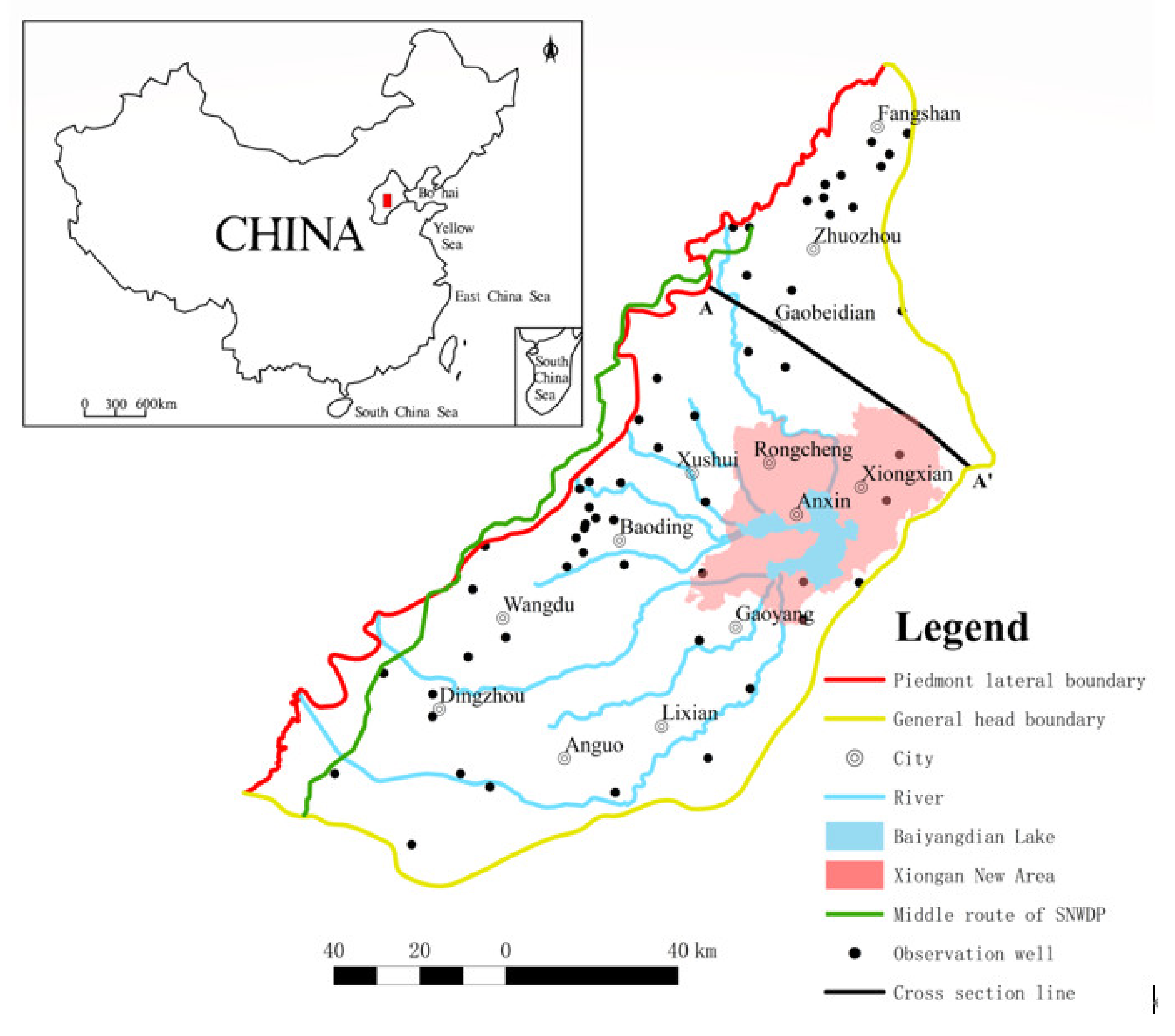

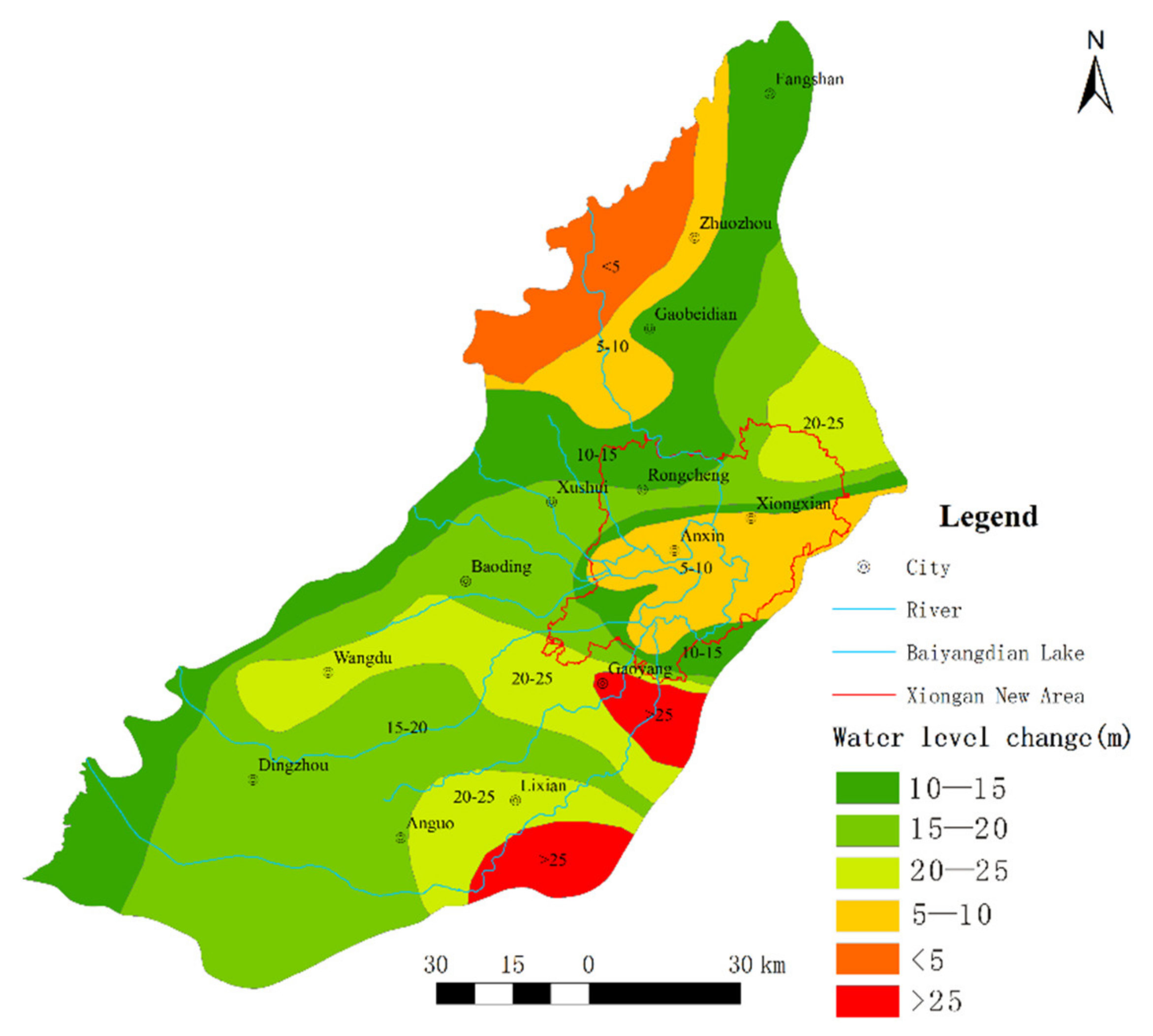

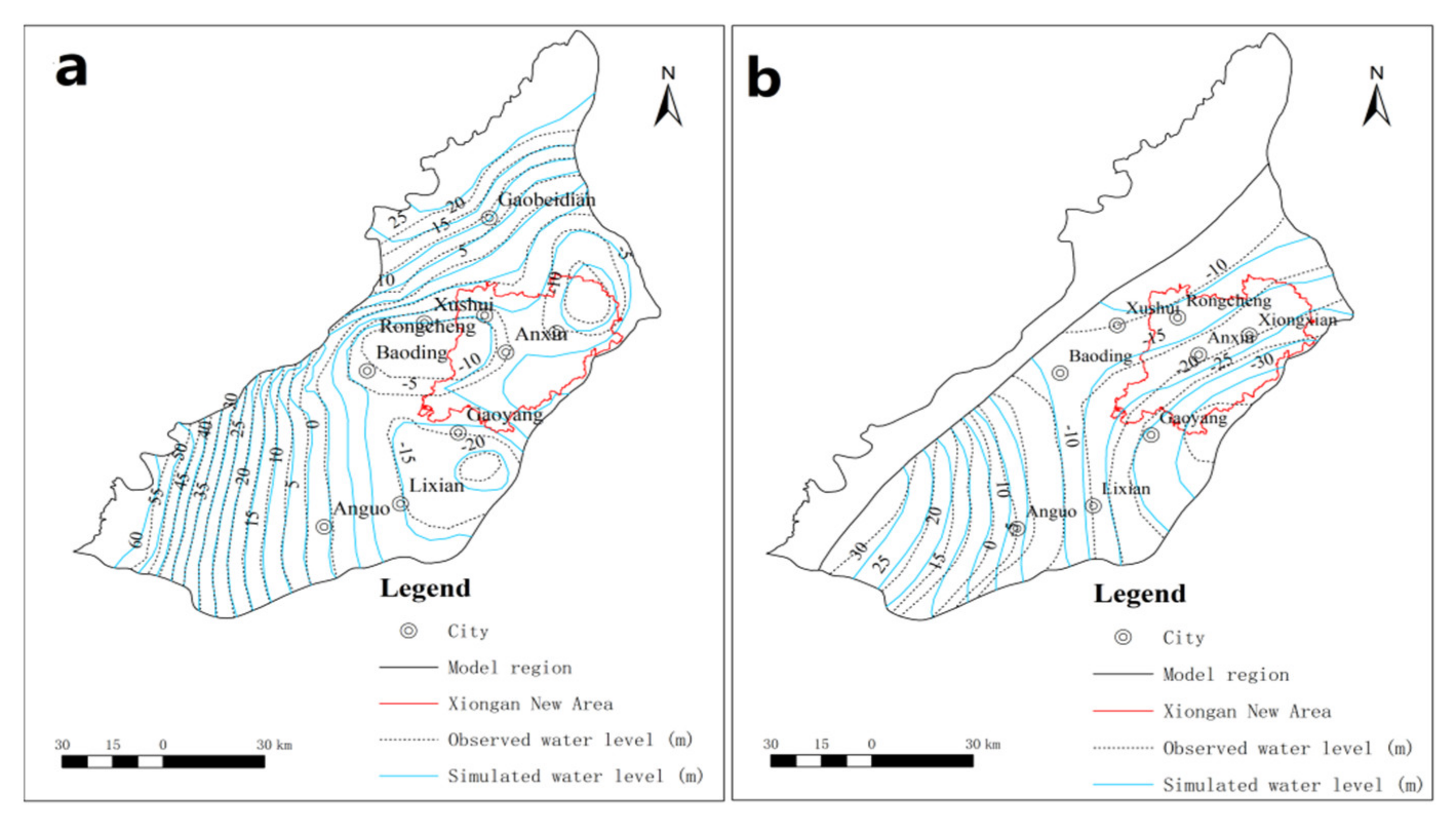
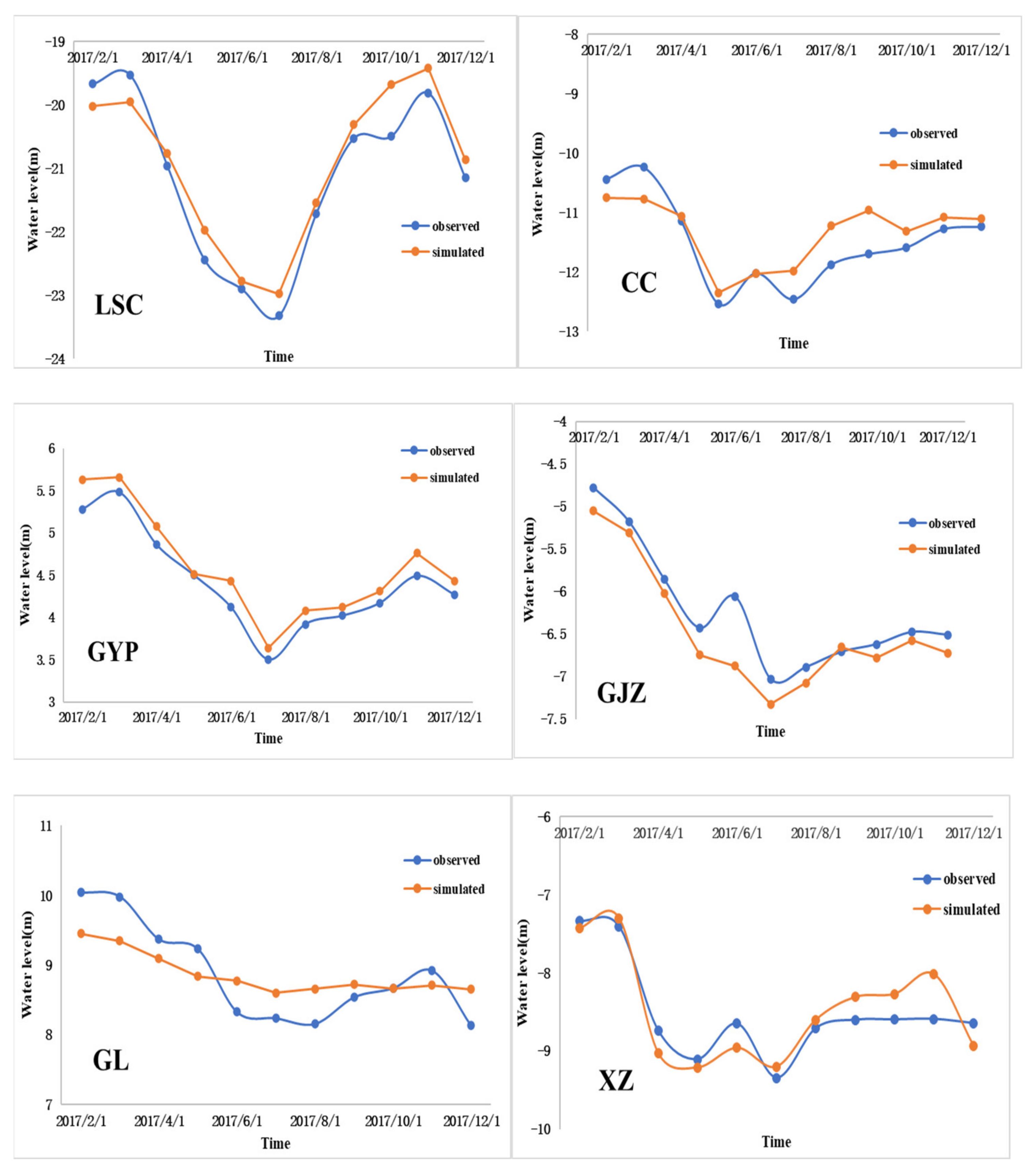


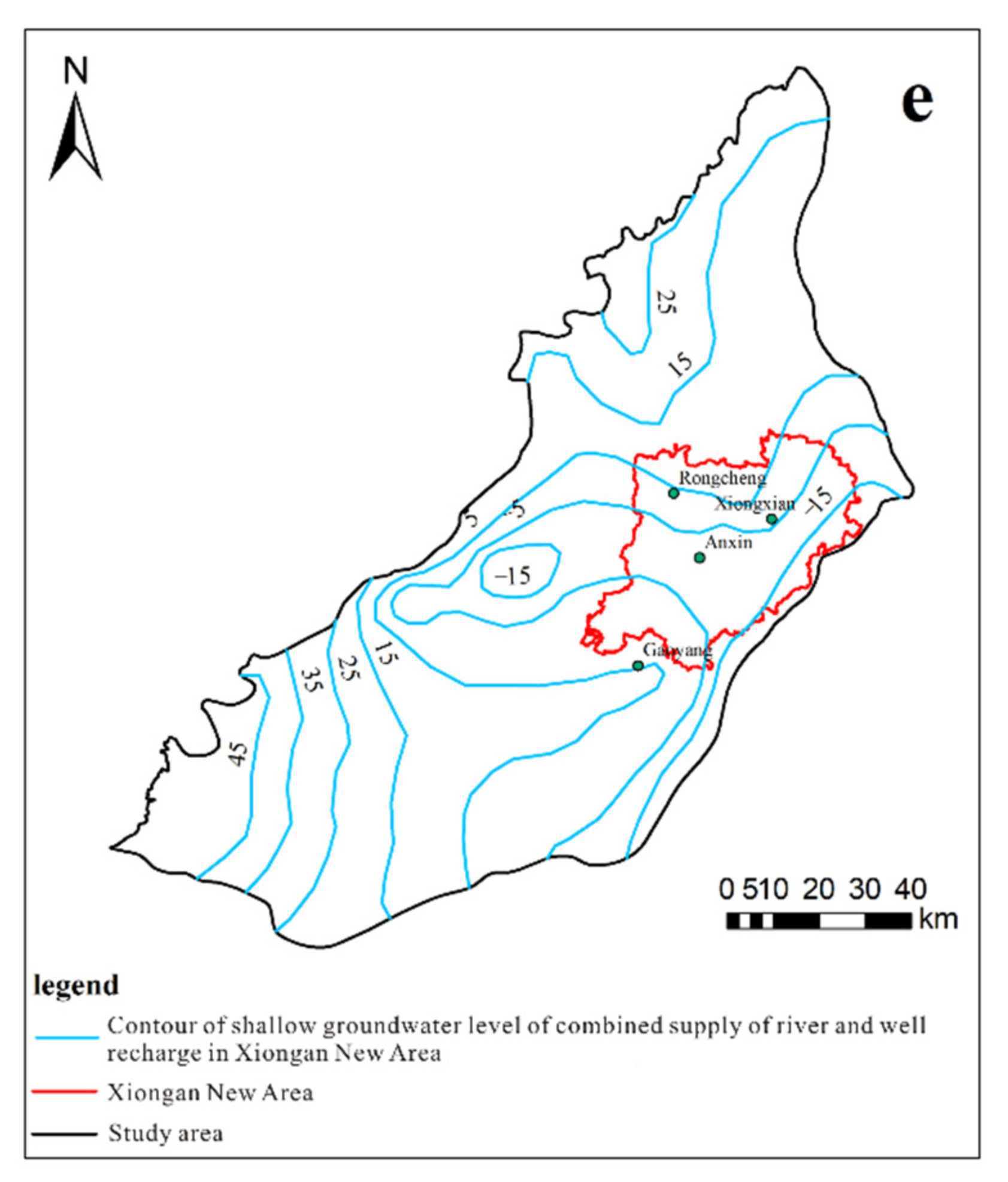
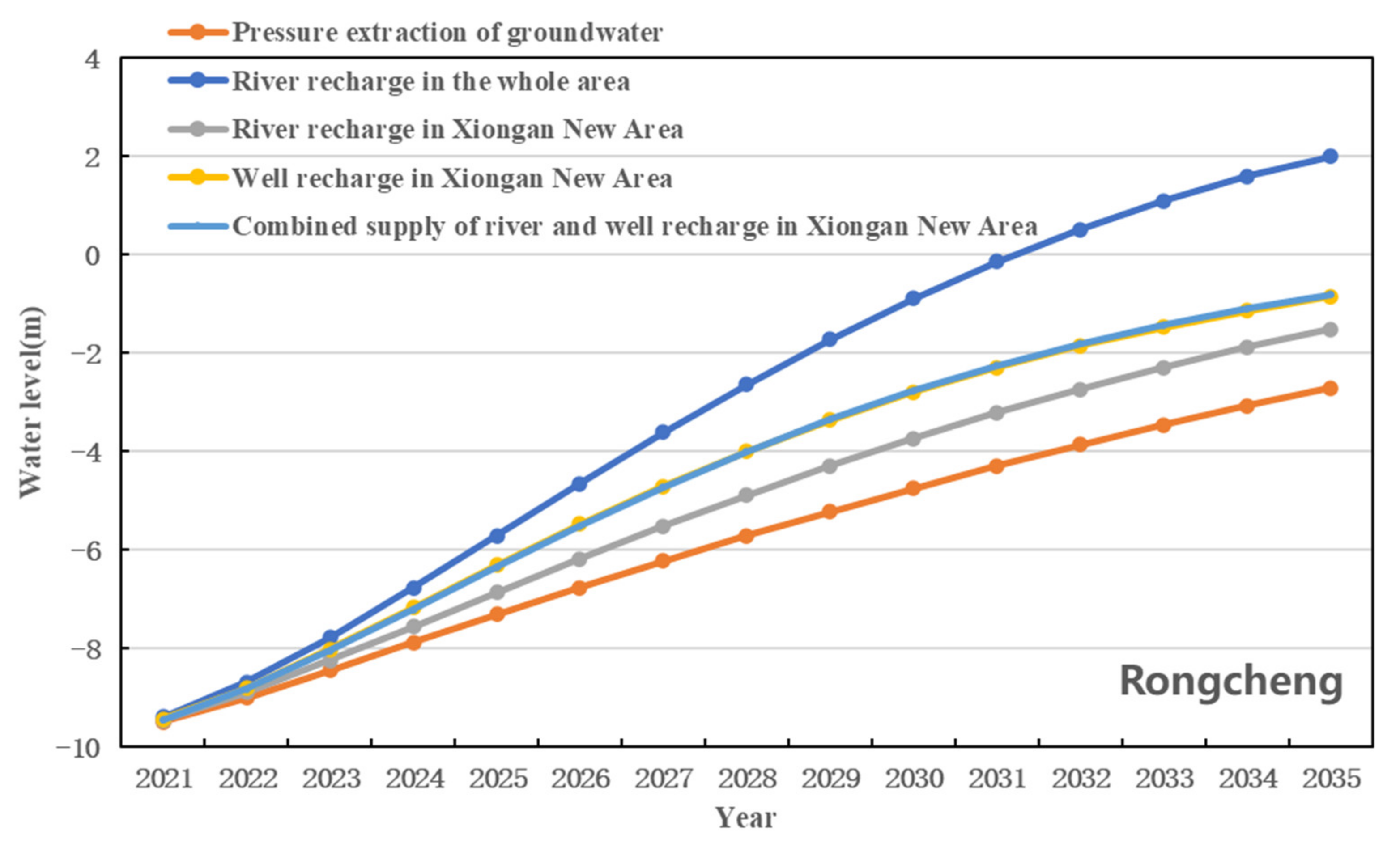

| Model Layer | Parameters | ||||
|---|---|---|---|---|---|
| Hydraulic Conductivity (m/d) | Storage Parameters | Infiltration Coefficient of Precipitation | Infiltration Coefficient of Irrigation | Extinction Depth (m) | |
| 1 | 3–80 | 0.02–0.15 | 0.18–0.25 | 0.115 | 4 |
| 3 | 0.5–15 | 10−4–10−6 | - | - | - |
| Time | Source-Sink Term | Current Situation | Pressure Extraction of Groundwater | Artificial Recharge under a Reduction in Groundwater Exploitation | ||||
|---|---|---|---|---|---|---|---|---|
| River GW across the Entire Area | River GW Recharge | Well GW Recharge | Combined River and Well GW Recharge | |||||
| 2035a | Recharge | Precipitation infiltration | 114.46 | 114.46 | 114.46 | 114.46 | 114.46 | 114.46 |
| Lateral inflow | 29.77 | 22.56 | 23.21 | 21.09 | 18.33 | 18.39 | ||
| Irrigation infiltration | 19.92 | 19.92 | 19.92 | 19.92 | 19.92 | 19.92 | ||
| River infiltration | 26.65 | 26.65 | 38.93 | 33.10 | 26.65 | 27.81 | ||
| Infiltration of Baiyangdian Lake | 31.82 | 26.99 | 25.84 | 26.96 | 26.40 | 26.44 | ||
| Well irrigation | 0 | 0 | 0 | 0 | 49.28 | 40.15 | ||
| total | 222.62 | 210.58 | 222.36 | 215.53 | 255.03 | 247.18 | ||
| Rate of change from the current situation | 0 | −5.41% | −0.12% | −3.18% | 14.56% | 11.04% | ||
| Discharge | Artificial exploitation | 227.00 | 158.90 | 158.90 | 158.90 | 158.90 | 158.90 | |
| Lateral outflow | 34.76 | 25.31 | 20.84 | 26.17 | 31.54 | 31.40 | ||
| Evaporation | 0 | 0 | 44.24 | 18.17 | 56.80 | 49.37 | ||
| Total | 261.76 | 184.21 | 223.98 | 203.24 | 247.24 | 239.67 | ||
| Rate of change from the current situation | 0 | −29.63% | −14.43% | −22.36% | −5.54% | −8.44% | ||
| Storage variation | 11.15 | 58.70 | 66.59 | 60.89 | 57.78 | 57.93 | ||
Publisher’s Note: MDPI stays neutral with regard to jurisdictional claims in published maps and institutional affiliations. |
© 2021 by the authors. Licensee MDPI, Basel, Switzerland. This article is an open access article distributed under the terms and conditions of the Creative Commons Attribution (CC BY) license (https://creativecommons.org/licenses/by/4.0/).
Share and Cite
Chi, G.; Su, X.; Lyu, H.; Xu, G.; Zhang, Y.; Li, N. Simulating the Shallow Groundwater Level Response to Artificial Recharge and Storage in the Plain Area of the Daqing River Basin, China. Sustainability 2021, 13, 5626. https://doi.org/10.3390/su13105626
Chi G, Su X, Lyu H, Xu G, Zhang Y, Li N. Simulating the Shallow Groundwater Level Response to Artificial Recharge and Storage in the Plain Area of the Daqing River Basin, China. Sustainability. 2021; 13(10):5626. https://doi.org/10.3390/su13105626
Chicago/Turabian StyleChi, Guangyao, Xiaosi Su, Hang Lyu, Guigui Xu, Yiwu Zhang, and Ningfei Li. 2021. "Simulating the Shallow Groundwater Level Response to Artificial Recharge and Storage in the Plain Area of the Daqing River Basin, China" Sustainability 13, no. 10: 5626. https://doi.org/10.3390/su13105626







